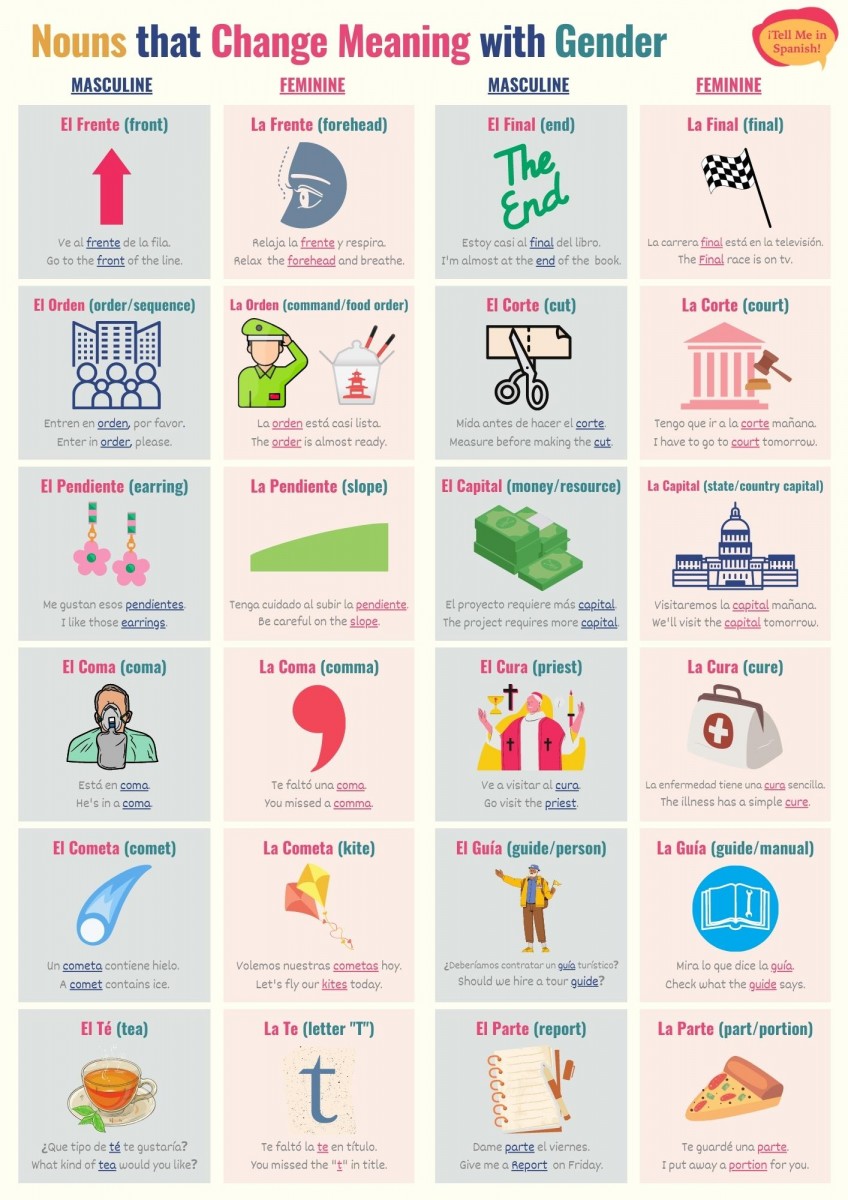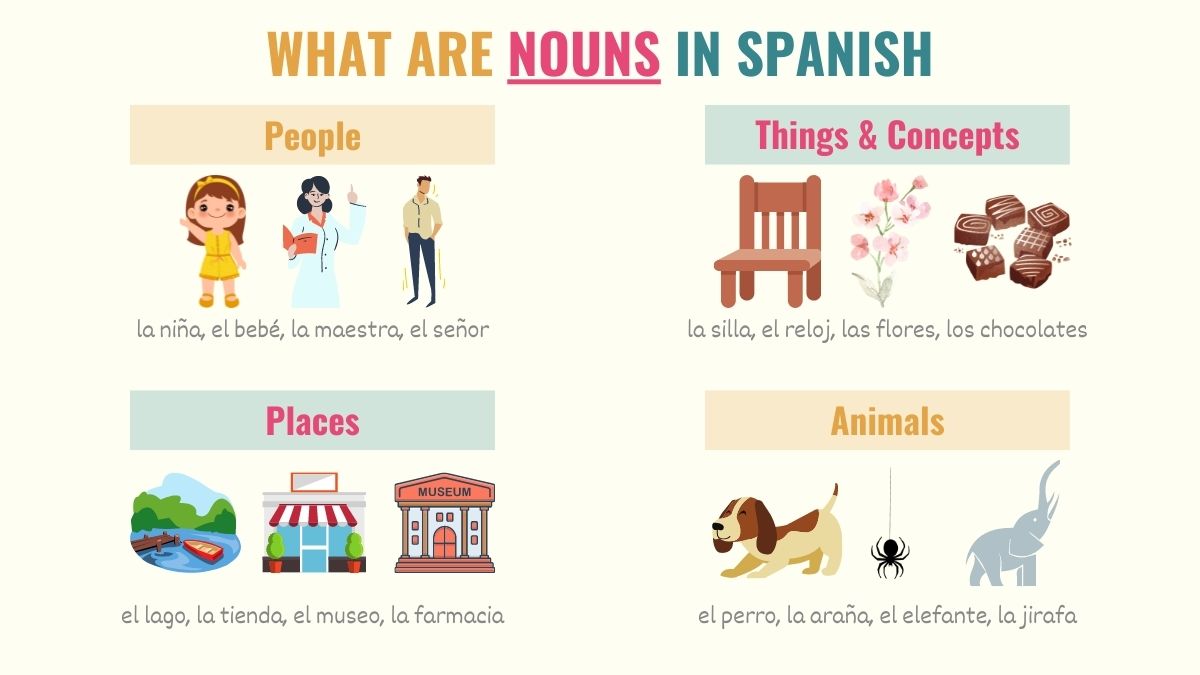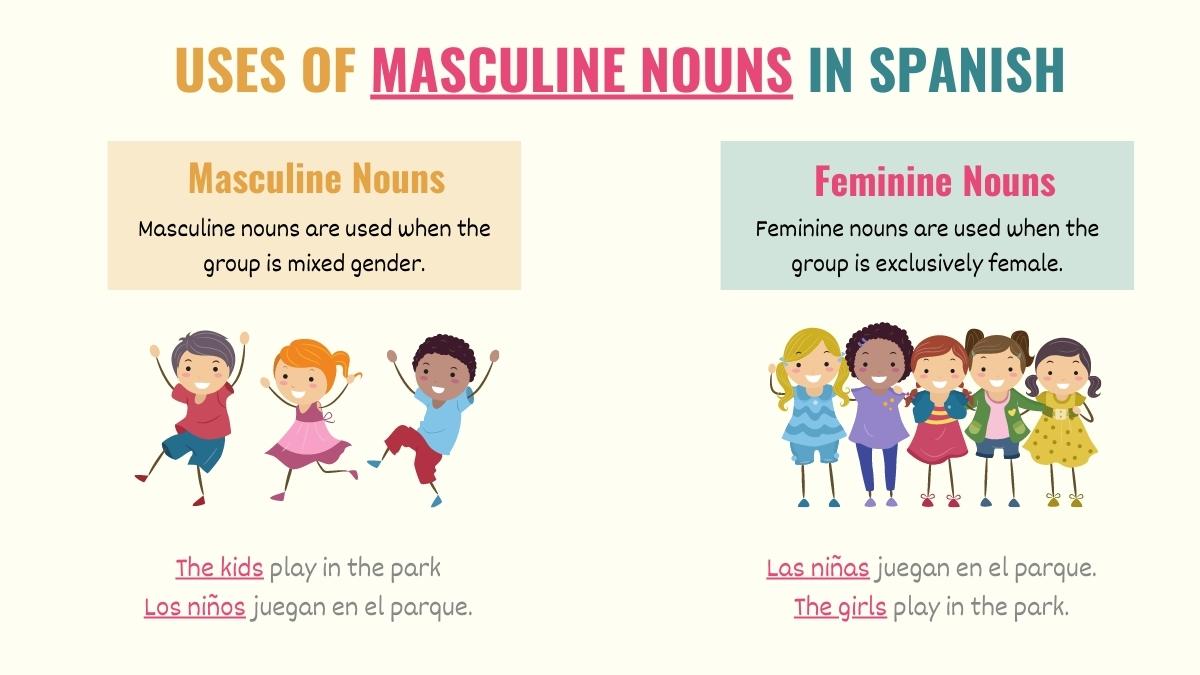One of the first things you’ll find out when learning Spanish is that all nouns have a gender. This means that every time you use a noun, you must express whether it’s a feminine or masculine word. Given that this may be a new concept for new learners, many people wonder what grammatical gender in Spanish is.
Grammatical gender is a property of Spanish nouns. This attribute allows us to classify words as either masculine or feminine. In Spanish, all nouns have a gender. To keep the sentence consistent, adjectives, articles, and pronouns must agree in gender and number with the noun they modify.
Not knowing if a word is feminine or masculine in Spanish can lead to poor communication and, in some cases, misunderstandings. For that reason, in this guide, I’ll provide you with all the key information you need to know to determine the gender of nouns in Spanish.
Here is a quick overview of the topics we’ll cover:
- How Does Spanish Gender Work
- Rules for Feminine and Masculine Words
- Frequently Asked Questions
- Key Points
By the end of this article, you’ll have a more solid understanding of how Spanish gender works.
Get a Step-by-Step Map to Learning Spanish
Join the Tell Me In Spanish community and get a copy of my step-by-step Spanish Learner’s Roadmaps and tricky synonyms & vocab cheat sheets.
How Does Spanish Gender Work
As a romance language, Spanish has grammatical gender whose purpose is to express whether a noun is masculine or feminine. The Spanish gender can be distinguished with certain endings or by checking the gender of the adjectives, pronouns and Spanish articles surrounding that word.
La casa blanca es muy bonita.
The white house is very pretty.
Nuestros perros son pequeños.
Our dogs are small.
Many students assume that confusing the gender of words in Spanish is not a big deal. In many cases, the worst that can happen to you is that your Spanish will not sound very good:
Incorrecto
La problema es que no tengo tiempo.
The problem is that I don’t have time.
Su mano es muy pequeño.
His hand is very small.
However, in certain situations, changing the gender of a noun can also change its meaning, as you can see in the graphic and examples below:

Me gustan las cerezas.
I like cherries.
Mi mamá tiene un cerezo.
My mom has a cherry tree.
Me corté la frente.
I cut my forehead.
Hay un frente frío en la ciudad.
There’s a cold front in the city.
Take Note: The gender of a noun in Spanish affects determiners, adjectives, and some pronouns. To put it in simple terms, if you’re working with a Spanish masculine noun, you must make sure its modifiers are also masculine.
[Determiner] + [noun] + [verb conjugated] + [adjective]
Nuestro coche está sucio.
Our car is dirty.
Esta camisa es negra.
This t-shirt is black.
Rules for Feminine And Masculine Words in Spanish
A Spanish noun is a word we use to name people, things, concepts, places, and animals.

As established before, a Spanish noun can be classified as masculine or feminine depending on its gender. For living things (such as people and animals), the grammatical gender is associated with the biological gender:
El perro de Luis es blanco.
Luis’ dog is white.
Mi gatita está enferma.
My kitty is sick.
El mecánico trabaja todos los días.
The mechanic works every day.
La mesera descansa los jueves.
The waitress doesn’t work on Thursday.
However, things start getting tricky when determining the gender of objects and concepts. After all, how can you know if problema and mano are feminine or masculine? For these types of cases, there are certain guidelines that can give you a better idea of how Spanish gender is formed.
In the following sections, we’ll explore some of Spanish’s most important rules for feminine and masculine nouns. Be aware that these guidelines are not set in stone, and there are some exceptions that you’ll need to memorize. So, we’ll cover those exceptions below, too.
Masculine noun endings
In Spanish, the following nouns are always masculine:
- Cities and countries that end with a consonant.
- Countries and cities that end with a vowel other than ‘a’.
- Names of lakes, oceans, seas, and rivers.
Check these examples:
(Determiner] +[noun] + [verb conjugated] + [complement]
Uruguay es muy bonito.
Uruguay is very pretty.
Singapur es muy caro.
Singapore is very expensive.
El Amazonas es el río más largo del mundo.
The Amazon River is the world’s largest river.
Take Note: When it comes to living things (people and animals), masculine nouns are always used when referring to a mixed group (no matter how many females or males are) or when talking about the group as a whole.
Los niños juegan en el parque.
The kids play in the park.
Mis perros son muy tranquilos.
My dogs are very quiet.

In the sections below, you’ll find tables with the most common endings for masculine words in Spanish. Make sure you pay attention to the exceptions column.
Masculine nouns that end in -o
As you may already know, most masculine words in Spanish end with ‘-o’. But, as you’ll see in the examples below, some popular words are the exception to this rule.
| Ending | Masculine noun examples | Exceptions |
|---|---|---|
| -o | El equipo (team) | La mano (hand) La moto* motorcycle) La foto* (photo) La radio (radio) |
| El zapato (shoe) | ||
| El dinero (money) | ||
| El café (coffee) | ||
| El accidente (accident) | ||
| El restaurante (restaurant) | ||
| El paciente (patient) | ||
| El maquillaje (make up) | ||
| El ejercicio (exercise) | ||
| El beso (kiss) | ||
| El queso (cheese) | ||
| El carro (car) | ||
| El barco (boat) | ||
| El cuarto (room) |
*Note: la moto and la foto are a shortened version of the feminine words ‘motocicleta’ and ‘fotografía’.
[Determiner] + [noun] + [complement]
El diseño de mi prima no está terminado.
My cousin’s design is not finished.
Sus zapatos son muy caros.
His shoes are very expensive.
El plato es blanco con rayas azules.
The dish is white with blue stripes.
Spanish Masculine nouns that end in -e
| Ending | Masculine noun examples | Exceptions |
|---|---|---|
| -e | El juguete (toy) | La madre (mother) La gente (people) La leche (milk) La nube (cloud) La noche (night) |
| El pie (foot) | ||
| El té (tea) | ||
| El café (coffee) | ||
| El accidente (accident) | ||
| El restaurante (restaurant) | ||
| El paciente (patient) | ||
| El maquillaje (make up) | ||
| El dulce (candy) |
[Determiner] + [noun] + [complement]
Quiero un té helado.
I want an iced tea.
Este restaurante es muy famoso.
This restaurant is pretty famous.
El maquillaje de Claudia es muy bueno.
Claudia’s make-up is very good.
Masculine nouns that end in -l
| Ending | Masculine noun examples | Exceptions |
|---|---|---|
| -l | El control (remote) | La señal (sign) La cárcel (jail) La sal (salt) La moral (morals) |
| El árbol (tree) | ||
| El albañil (builder) | ||
| El ángel (angel) | ||
| El comercial (commercial) | ||
| El mantel (table cloth) | ||
| El labial (lipstik) | ||
| El hospital (hospital) | ||
| El fútbol (soccer) | ||
| El manual (manual) | ||
| El hotel (hotel) | ||
| El pastel (cake) | ||
| El papel (paper) |
[Determiner] + [noun] + [complement]
El fútbol es muy aburrido.
Soccer is very boring.
¡Qué bonito está tu labial!
Your lipstick is so pretty!
Ese árbol es muy viejo.
That tree is very old.
Spanish masculine nouns that end in -r
| Ending | Masculine noun examples | Exceptions |
|---|---|---|
| -r | El color (color) | La flor (flower) La mujer (woman) |
| El calor (heat) | ||
| El dolor (pain) | ||
| El sabor (flavor) | ||
| El vestidor (dressing room) | ||
| El lugar (place) | ||
| El marcador (marker) | ||
| El azar (fate) | ||
| El collar (necklace) | ||
| El lunar (mole) | ||
| El olor (hodor) | ||
| El tenedor (fork) | ||
| El bar (bar) | ||
| El suéter (sweater) |
[Determiner] + [noun] + [complement]
El bar está lleno.
The bar is crowded.
Tu suéter es rojo.
Your sweater is red.
El vestidor está ocupado.
The dressing room is occupied.
Masculine nouns that end in -n
| Ending | Masculine noun examples | Exceptions |
|---|---|---|
| -n | El avión (plane) | La imagen (image) Words ending with -ión. |
| El abdomen (abdomen) | ||
| El bastón (cane) | ||
| El sartén (pan) | ||
| El delfín (dolphin) | ||
| El huracán (hurricane) | ||
| El pulmón (lung) | ||
| El orden (order) | ||
| El tiburón (shark) | ||
| El sillón (couch) | ||
| El volumen (volume) | ||
| El salmón (salmon) |
[Determiner] + [noun] + [complement]
Los delfines son adorables.
Dolphins are adorable.
Me encanta el salmón ahumado.
I love smoked salmon.
Este sillón es muy cómodo.
This couch is very comfortable.
Spanish masculine words ending with -z
While most nouns that end with a particular consonant or vowel are generally classified as either masculine or feminine, nouns that end with ‘z’ do not follow a guideline. This is the only noun ending that does not have a guideline gender classification. Therefore, you simply need to memorize the gender of words that end with ‘z’.
| Ending | Masculine noun examples |
|---|---|
| -z | El lapiz (pencil) |
| El tapiz (wallpaper) | |
| El pez (fish) | |
| El arroz (rice) | |
| El maíz (corn) |
[Determiner] + [noun] + [complement]
El maíz está crudo.
The corn is raw.
El pez es negro.
The fish is black.
Take Note: To pluralize these Spanish words, you must change the ‘-z’ for the ending ‘-ces’.
Los peces son muy bonitos.
Fish are very pretty.
Feminine nouns endings
In the tables below, you’ll find the most common endings for feminine words in Spanish.
Feminine nouns ending with -a
The ending ‘-a’ is a good indicator that you’re most likely dealing with a feminine Spanish word. However, this doesn’t mean that all words that end with an ‘-a’ are feminine. In fact, a few masculine words also end with this vowel.
| Ending | Feminine noun examples | Exceptions |
|---|---|---|
| -a | La lata (can) | El día (day) El mapa (map) Words that finish in ‘-ma’ such as: El problema (problem) El sistema (system) El idioma (language) El clima (whether) El programa (program) |
| La cama (bed) | ||
| La taza (cup) | ||
| La lluvia (rain) | ||
| La escuela (school) | ||
| La camisa (t-shirt) | ||
| La botella (bottle) | ||
| La guitarra (guitar) | ||
| La rama (branch) | ||
| La palma (palm) | ||
| La broma (joke) | ||
| La pluma (pen) |
[Determiner] + [noun] + [complement]
La comida estuvo muy rica.
The food was delicious.
Estas manzanas están muy agrias.
These apples are very sour.
La botella de Suzy está vacía.
Suzy’s bottle is empty.
When referring to people or animals, most of the time Spanish nouns can be transformed into feminine words by simply replacing the ‘-o’ with an ‘-a’.
La maestra tiene dos gatitas.
The teacher has two kitties.
Tu vecina es muy ruidosa.
Your neighbor is very noisy.
Take Note: Do not get mixed up! You’ll find a few Spanish singular feminine words that end with ‘-a’ that are preceded by a masculine article. We only do this when those words start with a stressed ‘a’ sound. This allows us to ease the pronunciation!
El agua está fría.
The water is cold.
Las aguas azucaradas son malas para la salud.
Sugared water is bad for your health.
Because ‘aguas’ is plural in the second example, the ‘s’ on the end of the article ‘las’ breaks up the stressed ‘a’ in ‘aguas’. Which is why it uses the article ‘las’ which correctly matches the noun’s gender.
Spanish feminine nouns ending with -ión
As you learned before, many Spanish masculine words end with ‘-n’. But if you paid close attention to those words, you may have noticed that none of them had the suffix ‘-ión’:
El balcón es muy grande.
The balcony is very big.
El patín eléctrico es muy práctico.
The electric scooter is very practical.
Why? Because all the nouns that end with ‘-ión’ are feminine words in Spanish.
| Ending | Feminine noun examples | Exceptions |
|---|---|---|
| -ión | La mansión (mansion) | NONE |
| La canción (song) | ||
| La decisión (decision) | ||
| La colección (collection) | ||
| La televisión (TV) | ||
| La imaginación (imagination) | ||
| La opción (option) | ||
| La conexión (connection) | ||
| La natación (swimming) | ||
| La habitación (room) |
La canción es muy larga.
The song is too long.
Su habitación es morada.
Her bedroom is purple.
Tomó la decisión equivocada.
He made the wrong decision.
Spanish feminine nouns ending with -ad
Other nouns that are always feminine are those words that end with ‘-ad’ or ‘-ed’.
| Ending | Feminine noun examples | Exceptions |
|---|---|---|
| -ad / – ed | La felicidad (happiness) | NONE |
| La sed (thirst) | ||
| La verdad (truth) | ||
| La mitad (half) | ||
| La amistad (friendship) | ||
| La cualidad (quality) | ||
| La autoridad (authority) | ||
| La lealtad (loyalty) | ||
| La facultad (faculty) | ||
| La pared (wall) |
[Determiner] + [noun] + [complement]
La pared está recién pintada.
The wall is newly painted.
Lucía tiene cualidades muy buenas.
Lucia has very nice qualities.
La verdad puede ser dolorosa.
The truth can be painful.
Spanish feminine nouns ending with -z
Remember that nouns that end with ‘z’ do not follow a default gender guideline. So, it’s important to memorize the feminine words that end with the consonant ‘z’.
| Ending | Feminine noun examples |
|---|---|
| -z | La voz (voice) |
| La nuez (nut) | |
| La cruz (cross) | |
| La luz (light) | |
| La vejez (old age) | |
| La paz (peace) | |
| La nariz (nose) |
[Determiner] + [noun] + [complement]
Su nariz es pequeña.
His nose is small.
Tu voz es muy chillona.
Your voice is so high-pitched.
La luz es bastante brillante.
The light is quite bright.
Spanish gender exceptions
So far, you’ve learned some of the most common endings used to form feminine and masculine words in Spanish and their exceptions. In addition to these anomalies, there are other Spanish gender exceptions that you must keep in mind.
Irregular nouns that change depending on the gender
In Spanish, some nouns use different words for the masculine and feminine forms. These nouns are:
| Spanish masculine noun | Spanish feminine noun | Translation |
|---|---|---|
| Caballo | Yegua | Horse / Mare |
| Toro | Vaca | Bull / Cow |
| Yerno | Nuera | Son / Daughter in law |
| Papá | Mamá | Dad / Mom |
| Cura | Monja | Priest / Nun |
| Hombre | Mujer | Man / Woman |
| Caballero | Dama | Gentleman / Lady |
| Carnero | Oveja | Sheep |
| Actor | Actriz | Actor / Actress |
Mi caballo es negro y mi yegua parda.
My horse is black and my mare brown.
El toro es muy agresivo y la vaca muy tranquila.
The bull is very aggressive, and the cow is very calm.
Nouns with immutable endings
As established before, when it comes to people, you can usually form the Spanish gender by changing the ‘-o’ for an ‘-a’. However, there are certain words whose endings are unalterable.
Watch out! Many people learning Spanish assume that these are neutral nouns. But as you already know, there is no such thing as neutral nouns in Spanish. With these types of nouns, you still have to mark the gender. To do so, you’ll use Spanish articles, adjectives, or pronouns.
These are some of the nouns whose endings cannot change. As you can see, most of them are nouns used to describe a person’s profession or occupation:
| Spanish | English |
|---|---|
| Turista | Tourist |
| Estudiante | Student |
| Periodista | Journalist |
| Juez | Judge |
| Astronauta | Astronaut |
| Paciente | Patient |
| Cantante | Singer |
| Dentista | Dentist |
| Cliente | Client |
| Agente | Agent |
| Piloto | Pilot |
| Testigo | Witness |
| Conserje | Concierge |
And here are some examples of what you can do to mark the gender of these words:
[Masculine or feminine determiner] + [noun]+ (adjective)
Esa cantante es muy talentosa.
That singer is very talented.
Esos cantantes son españoles.
Those singers are Spanish.
La juez es muy puntual.
The judge is always on time.
Los dentistas están muy jóvenes.
The dentists are very young.
El periodista trabaja todo el día.
The journalist works all day.
La periodista es muy insistente.
The journalist is very persistent.
Take Note: You can also imply the gender of these nouns by saying the name of the person you’re talking about.
José es dentista.
José is a dentist.
Frequently Asked Questions about Spanish Gender
Spanish gender is a complex topic. As a result, here are some frequently asked questions that most of my students usually have.
Do numbers in Spanish agree with gender?
When working as adjectives, numbers have to agree in gender and number with the noun they are modifying. As a result, depending on the noun, a number can be either feminine or masculine. This rule is only applicable to the following numbers:
- One (uno)
- Hundreds (starting at two hundred)
Tengo doscientos pesos.
I have two hundred pesos.
Encarga doscientas galletas.
Order two hundred cookies.
Tengo una pluma extra.
I have an extra pen.
Quiero un café, por favor.
I want a coffee, please.
Hubo mil quinientos invitados.
There were one thousand five hundred guests.
As mentioned above, this rule comes into effect with amounts superior to two hundred. Therefore, it’s correct to say:
Tengo cien pesos.
I have one hundred pesos.
Hay cien sillas disponibles.
There are one hundred chairs available.
How do number and gender affect adjectives in Spanish?
Most Spanish adjectives must agree in gender and number with the accompanying noun. This means that most Spanish adjectives will change their gender to match the noun. Adjectives that end with an ‘-e’ or a consonant cannot be modified to express the Spanish grammatical gender.
Sofía es muy inteligente.
Sofia is very smart.
Mi primo también es inteligente.
My cousin is also smart.
Tu casa es grande y bonita.
Your house is big and pretty.
Ese color es bonito.
That color is pretty.
Do colors change gender in Spanish?
If a color is working as a Spanish adjective, it will need to change its gender to agree with the noun unless such a color ends with a consonant or ‘-e’. On the other hand, when working as nouns, Spanish colors are always masculine.
Check these examples of sentences with colors in Spanish:
El rosa es mi color preferido.
Pink is my favorite color.
La camisa rosa es muy grande.
The pink t-shirt is too big.
Quiero un rojo más intenso.
I want a more intense red.
La mochila roja me gusta más.
I like the red bag more.
Why is dress masculine in Spanish?
Many people mistakenly think the gender of a noun in Spanish is determined by who uses that object. Because of this, most people assume that vestido is feminine, only to find out that they’re wrong. As explained before, a big portion of masculine words in Spanish end with an ‘-o’. Therefore, vestido (dress) is actually a masculine noun.
Incorrect
Me gusta la vestido rosa.
I like the pink dress.
Correct
Me gusta el vestido rosa.
I like the pink dress.
Key Points: Masculine & Feminine Words in Spanish
Spanish gender can be a challenging topic for many new and advanced learners. For that reason, this guide covers all the information you need to understand this topic. Here are some key points that you should keep in mind about masculine and feminine words in Spanish:
- Spanish grammatical gender allows you to classify words into masculine and feminine.
- For objects and concepts, Spanish gender is determined based on certain endings.
- People and animals’ gender is based on their biological gender or their gender identity.
- The gender for people and animals can be formed by replacing the ‘-o’ with an ‘-a’ or vice versa.
- Grammatical gender affects adjectives, articles, and Spanish determiners. This means that these words must agree in gender and number with the noun.
- The Spanish masculine gender can be used to talk about a mixed group or to refer to the group as a whole.
- Most Spanish masculine words end with ‘-o’, ‘l’, ‘e’, ‘r’ and ‘n’. However, some feminine words also have these endings. For example, la razón, la mano, and la mujer.
- Most feminine words in Spanish end with ‘-a’, ‘-ión’, ‘-ad’, ‘-ed’. There are also some exceptions, such as el día and el mapa.
- Singular feminine words that start with a stressed ‘a’ sound must be preceded by a masculine article. Since this is only done for pronunciation purposes, the word remains feminine.
- Certain nouns related to professions have fixed endings. In these cases, we use articles, adjectives, and pronouns to mark the gender.

